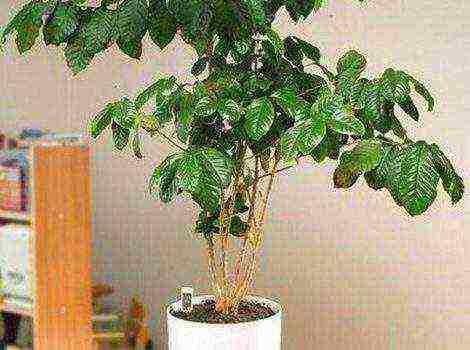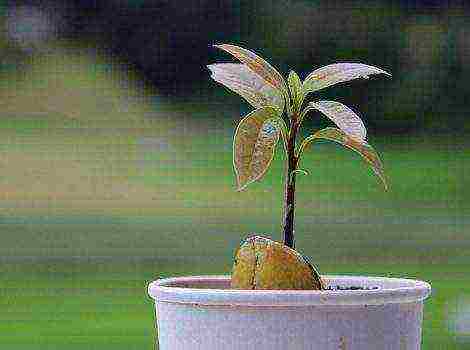Content [show]
Today we will look at growing Badan from seeds in the open field and find out what are the features in caring for a plant. Let's discuss the prevention of diseases and pests. We will also analyze common mistakes made by florists and answer the most common questions.
Badan is a herbaceous perennial plant with medicinal and ornamental value. In its natural environment, it grows in the temperate zone of the Northern Hemisphere. Badan can be found on the territory of Primorye, Altai Territory, Siberia. Grows well on mountain slopes, rocky and forest-steppe areas.
Badan has a powerful root system. The leaves are large, leathery, remain green until late autumn, which allows this plant to be attributed to the group of evergreens. However, the leaves of some Badan species acquire a bronze, brown or burgundy hue in the fall. The plant forms a rosette. Read also the article: → "Growing garden yucca: planting, care, breeding features"
Blooms from late March to late May. Depending on the species and variety, Badan flowers are colored pink, purple, white and red. The flowers are goblet or bell-shaped. Flowers are collected in paniculate inflorescences located on a high peduncle.

The diameter of Badan flowers is not more than 2 cm.In one inflorescence, there are up to 120 flowers
Growing Badan from seeds in the open field: conditions
Badan grows well on light and loose soils. Well tolerates alkaline and moist soils. For planting Badan, areas located in partial shade or under the canopy of tall trees are suitable. When planted in a sunny area, the growth and development of the plant is weakened, spots in the form of burns form on the leaves, the inflorescences are drooping, the flowers quickly fade.
The horizontal roots of the plant are located close to the soil surface, therefore, it is difficult to tolerate dry areas. To protect the root system, the soil is mulched, which allows it to retain moisture on the driest days.
The main care for badan is watering and thinning. The plant should be watered often, but in moderation, avoiding waterlogging of the soil. The thinning procedure is carried out in order to prevent the development of disease and pests.

Badan is a ground cover plant, forms dense thickets, thanks to which it clogs weeds
Step-by-step instructions for growing Badan from seeds
Badan begins to bear fruit in the second half of July and ends in mid-August. The seeds are contained in a dry capsule. Each box contains several hundred seeds. Seeds are small up to 2 mm.
Sowing seeds can be done in open ground and sown in containers for growing seedlings. Experienced gardeners recommend sowing seeds not immediately into open ground, but germinating in shallow trays. Reproduction at home will allow the seedlings to grow stronger before planting in open ground.
The generative way of breeding Badan is a lengthy process. The first 1.5-2 years, young plants obtained from seeds develop slowly and require care.

Badan seedlings bloom on average for 3-4 years from the moment of sowing
Seeds are sown in early spring in small containers. It is not recommended to plant the seeds deeply in the soil; it is enough to mix the seeds with clean coarse sand and distribute them evenly over the surface of the moist soil. The sowing is covered with foil and put out on the street under the snow. In the second half of March, sowing containers are brought into a warm room. The emergence of friendly seedlings begins in 25 days.
Young shoots dive when the first leaf appears. They are planted for growing in open ground in mid-May. However, seedlings are planted in a permanent place in the second year or as soon as the rosette of leaves reaches 10-12 cm. In the table, we will consider several types of purchased soil suitable for sowing Badan seeds:
| Soil types | Soil grade |
| Universal nutritious soil for growing seedlings. | "Living World" |
| Peat soil "Garden land" | Fart CJSC |
| Nutrient soil for seedlings "Krepysh" | "Fasco" |
| Nutritious peat soil for seedlings | "Permagrobusiness" |
The purchased soil contains a balanced composition of macro- and microelements, which is necessary for growing strong seedlings. Such soil, when watering, will prevent the formation of lumps and provide the plant with nutrients. Purchased soil will allow you to avoid the development of diseases and pests, the appearance of which is not uncommon when using fertilized soil taken from ready-made beds, greenhouses, flower beds. Read also the article: → "Care and cultivation of Buddley"
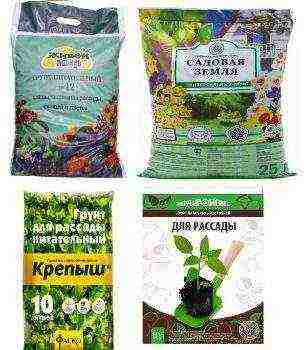
Purchased soil provides good oxygen access to the roots of young plants, and also allows you to evenly distribute moisture in the soil. The acidity of the soil is neutral
Tip # 1: To grow seedlings, you must use soil without decomposing organic matter. Such organics displace nitrogen compounds from the soil mixture. Nitrogen is necessary for the development of seedlings at the initial stage of growth. Moreover, during the decomposition of organic matter, a lot of heat is generated, which leads to overheating of the soil and the death of a still weak root system of young plants. Often, strong heating of the soil leads to the death of seeds.
Planting seedlings of Badan in open ground
Badan seedlings are planted in the spring - in mid-March. This period is most favorable for the rooting of young seedlings. With proper care, the seedlings will get stronger and accumulate all the necessary nutrients for the winter.
Before planting, the seedlings must be acclimated, namely, the seedlings must be taken out to the garden in early March on the warmest and most windless days. After a while, as soon as the matinees and night frosts are over, the seedlings are left overnight in an area under a plastic shelter. Then the shelter is removed and the plant continues to harden for several more days.
Before planting in open ground, seedlings are watered with liquid fertilizer containing nitrogen-phosphorus compounds. Such feeding will speed up the rooting of seedlings in a new place. Before planting seedlings in open ground, it is necessary to prepare the soil. The soil should be light and loose, such soil warms up well with weak rays of the sun. If the soil is clayey, it is necessary to add sand; a little clay is added to sandy soils. The holes in the soil are formed with a depth of no more than 2-2.5 cm. Seedlings are planted in open ground together with an earthen clod. Seedlings are placed at a distance of 10-12 cm. After planting, the seedlings are moderately watered with water at room temperature.
Tip # 2: After planting in open ground, Badan seedlings must be covered with a film. This will protect young plants from sudden frosts, bright rays of the sun, heavy rainfall and pests. The film is periodically opened to air the seedlings. As soon as the plant takes root, the film is removed.
The planted seedlings must be mulched. Mulch in the early stages of plant development will suppress the growth of weeds, retain the required amount of moisture and heat in the soil. In the table, consider a suitable material for mulching young Badan plants:
| Organic mulch | Inorganic mulch |
| pine needles | agrofibre |
| straw | expanded clay |
| mature compost | black film |
Organic mulches, in addition to retaining heat and moisture in the soil and protecting against weeds, improve the structure of the topsoil. Inorganic mulches shade the soil well and retain moisture, but on persistent hot days can overheat the soil or cause a greenhouse effect.
Cultural varieties of Badan for planting in the garden
In nature, there are about 10 species of Badan, from which garden forms of the plant were obtained. Garden forms of Badan are hybrids of various origins. In the table, we will consider the varietal characteristics of each of the above varieties of Badan:
| Garden varieties | Plant height (cm) | Features of flowers | Leaf features |
|
"Pacific" |
45-50 | Inflorescences are dense, flowers are reddish-pink | Ellipsoidal leaf shape. Green in spring and summer, red and burgundy by autumn |
| "Thick-leaved" | 45-50 | Flowers are large up to 2 cm, dark pink | The leaves are wide, tough, fleshy. In spring, summer - light green, by autumn - red-brown with shine |
| "Heart-leaved" | 30-35 | Inflorescences are pink or bright purple | Leaves are heart-shaped, hard, smooth, shiny. In spring, in summer, green, by autumn - red and burgundy |
| Schmidt | 35-40 | Inflorescences of bright scarlet color | Ellipsoidal form of leaves In spring, in summer the leaves are dull, green, by autumn - green with a blue tint. |
| "Bach" | 35-40 | Pineal inflorescences, white flowers | Ellipsoid, rigid. Dark green in spring and summer, brown by autumn |
To grow Badan, it is necessary to prepare such areas on which the plant will grow for 8-10 years. It is important to remember that all garden forms of Badan are difficult to tolerate the transplantation procedure.
All Badan varieties do not like stagnant water in the soil, and also do not tolerate exposure to direct sunlight. Waterlogged soil often leads to rotting of the root system.
Badan is rarely affected by diseases and pests. The development of the disease is observed only with improper care of the plant. The absence of pests is due to the specific chemical composition of the plant, which repels the vast majority of pests. Experienced gardeners note that Badan is affected by the penny drool and nematodes. Pennitsa appears if the plant is planted in shady areas with frequent accumulation of water in the soil. Nematodes develop in the soil when a large amount of organic matter is introduced.
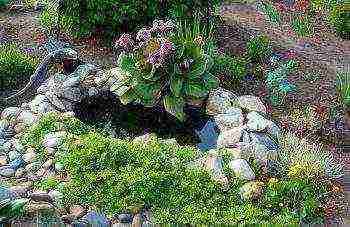
Badan looks spectacular against the background of artificial reservoirs and among stones
As a preventive measure for the development of diseases and the appearance of pests, it is necessary to regularly remove dead aerial plant organs, as well as timely remove fallen leaves and weeds. With a thickened planting, it is recommended to carry out a thinning procedure.
Badan in landscape design
Garden forms of Badan are widely used as an ornamental plant for decorating shady areas in the garden. Such a planting creates the appearance of a natural natural landscape in the form of an edge or a clearing. The plant looks harmoniously on the rocky areas of the personal plot, as well as as curbs. Due to the ornamental shape of the foliage and the bright color of the inflorescences, Badan is widely used in landscape design. Looks good in combination with narrow-leaved and variegated flower crops. Read also the article: → "Cultivation of knifophya: reproduction, planting and caring for a garden flower"
Badan looks good when planted along garden paths.Thanks to the horizontal root system that develops close to the surface, Badan successfully takes root and grows in areas with an uneven surface.
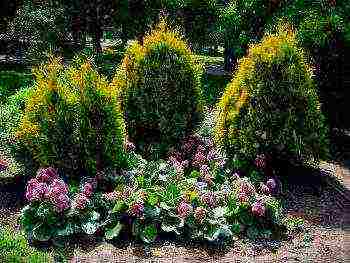
Badan looks organically in a composition with thuja and green needles
Serious mistakes of gardeners when growing Badan
The main mistakes are:
- The seeds are buried deep in the soil.
- Seedlings are planted in early spring without hardening.
- Rooted seedlings are not mulched.
- Produce frequent and abundant watering.
- Seedlings are grown in the sunniest areas.
Frequently asked questions from gardeners
Question number 1... What material should not be used to mulch Badan seedlings?
Answer: Such types of organic mulch as sawdust, wood shavings and bark, when rotted, extract nitrogen from the soil, which impairs the development and rooting of young plants. Fallen leaves should be used with extreme caution as mulch. It is not recommended to apply foliage from diseased trees and trees that have been treated with a chemical preparation.
Question number 2. When can an adult Badan plant be transplanted?
Answer: Badan does not tolerate a transplant. Transplanted in the middle of summer or in the first half of autumn.
Question number 3. The optimal age of the Badana plant for dividing the bush?
Answer: Badan is suitable for dividing the rhizome at the age of more than 5 years. Otherwise, the plant will not tolerate division well, which can lead to disease and death of the plant.
Question number 4... At what stage of Badan development can mineral fertilizers be applied?
Answer: They are fed with mineral fertilizers at the flowering stage and at the end.
Question number 5. Is it possible to sow Badan seeds directly into open ground?
Answer: It is not recommended to sow Badan seeds in open ground, the germination of such seeds is low. Sowing seeds in open ground is carried out at the end of March, until the end of April. Seedlings appear in about a month. For the winter, the seedlings are covered with straw. Blooms 3-4 years after planting.
Rate the quality of the article. We want to be better for you:
Few people know that from the dried leaves of a plant called badan, prepare very tasty, aromatic and, most importantly, healing tea. Unknowingly, many flower growers and gardeners throw out these dried wrinkled leaves.
Such tea in Altai (the homeland of badan) is called Chigir tea, in Siberia it was given a different name - Mongolian. With the onset of spring, the leaves, which were under the snow cover and have undergone natural fermentation, acquire healing properties... So, this unusual tea is able to strengthen the immune system, cure a large number of diseases, and it also has excellent tonic properties. Not so long ago, the dried leaves of this wonderful plant could be freely purchased on the market. Fresh green leaves of badan are not used to make medicinal tea, but they are used in the preparation of cabbage rolls (instead of cabbage leaves).
Once you have tasted this wonderful drink, you will certainly want to grow incense yourself, which is quite simple to do, since this plant is unpretentious, and it can also suppress the growth of weeds around it. With the onset of spring, you just have to collect the remaining leaves, rinse and dry them thoroughly, and then you can make delicious tea from them. These leaves are stored in canvas bags. By the way, this drink can be drunk at almost any age. It is noteworthy that the badan rhizome also has healing properties; medicinal ointments and decoctions are prepared from it.
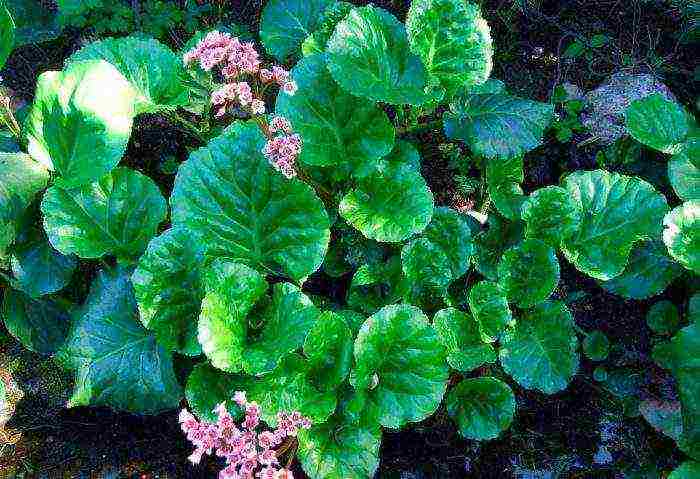
Badan is evergreen perennial and belongs to the family of saxifrage. It has not only medicinal properties, but also a spectacular appearance. This plant is also called bergenia (lat. Bergenia), and it is named so in honor of the German botanist and doctor Karl Bergen.
This plant has spectacular inflorescences of small goblet flowers. They are located on peduncles, on which leaves are completely absent.In one inflorescence, there are about 120 fairly large (up to 2 centimeters in diameter) flowers. Its shiny large leaves resembling elephant ears are collected in a rosette. That is why it is sometimes also called "elephant ears". This plant is able to bring zest to the architecture of any garden. So, it is often used when composing compositions with such narrow-leaved and variegated plants as arabis, hosta or phlox. They also look great when combined with rocks and small bodies of water.
There are only 10 types of bergenia, and most of them are suitable for growing in the garden. However, if you want to drink medicinal tea from this plant, then you will need to plant thick-leaved incense. To plant it, you need to choose a shaded place, preferably not far from the trees, or rather in their shade. If it is placed in a sunny place, then badan will grow extremely badly, and its development will occur slowly.
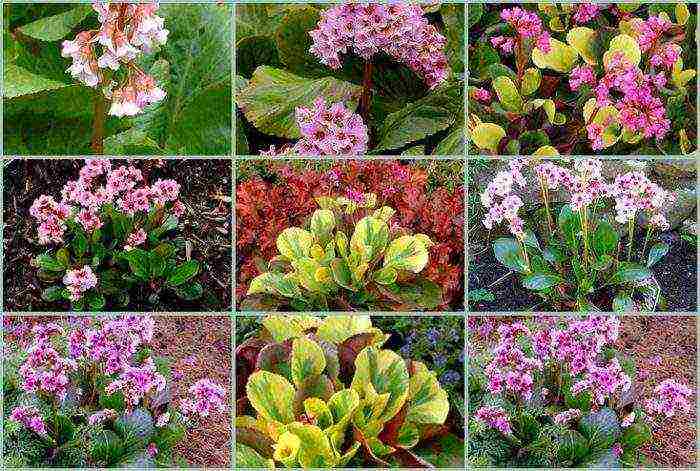
For planting badan, a fairly light, loose, moist and slightly alkaline earth is suitable, and all because its horizontal, thick roots are very weak. They are very close to the soil surface, and that is why it is so important not to allow the soil to dry out or moisture stagnation in it. In wild conditions, the root system is protected by fallen leaves, because they mulch the soil, helping to retain moisture in excessively dry weather, and they also protect the earth from waterlogging during heavy rains. When grown in gardens, these dry leaves are harvested in spring, like garbage, or they are collected as medicinal raw materials, and because of this, the root system is deprived of natural protection.
Badan is characterized by intensive growth. So, if you plant a couple of small shoots side by side after 2 or 3 years, they will completely cover the soil surface. A large number of evergreen silky leaves grow from the adventitious small roots of the maternal root system. In this regard, bergenia completely suppresses the growth of weeds near itself and it is not necessary to weed it.
Thick berry stalks of dark green color are selected from under the snow cover at the very beginning of spring. They grow very quickly, and already in the last weeks of April or the first weeks of May, flowering begins, which lasts until the end of June. Its flowers are collected in panicles and there is a small bloom of wax on their petals. These fragrant flowers are colored purple, bright red, pink or white. These spectacular panicles rise above the rosettes of ornamental leaves. In autumn, these leaves turn brown-lilac or bright bronze, and they remain so until spring. Badan can bloom twice a year, and the second bloom occurs in August or September.
Reproduction
Badan can be propagated by dividing a bush or by seeds.
How to grow badan from seeds
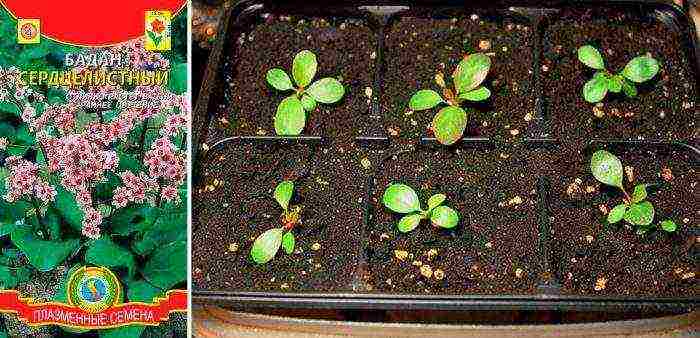
Sowing seeds should be done in the first half of March. To do this, it is advisable to prepare a wooden box (size 50x70 centimeters), adding purchased soil for flowers into it. Seeds are sown in grooves half a centimeter deep, spaced 3 centimeters apart. First, these grooves are carefully spilled with warm water, and then the seeds are sparsely poured. Place the box in partial shade, in a warm place (temperature between 18-19 degrees). Watering is carried out systematically. The sprouts will usually show up after 3 weeks. And after a month they can be thinned out. Seedlings are planted in the first days of June.
In the open ground, shallow holes are made (up to 6 centimeters), and it is recommended to place them in a checkerboard pattern of 40x40 centimeters. A small amount of sand is first poured into each hole, and then an earth mixture consisting of humus, loamy and sod soil, as well as sand mixed in a ratio of 1: 1: 2: 1. The development of plants is extremely slow. Before the onset of cold weather, they usually have 2 overgrowth leaves and this is quite normal.For the first winter, berry should be covered with peat or fallen leaves. In the following years, this is no longer necessary. This medicinal plant will bloom 3 or 4 years after planting.
Features of the breeding of badan by dividing the bush
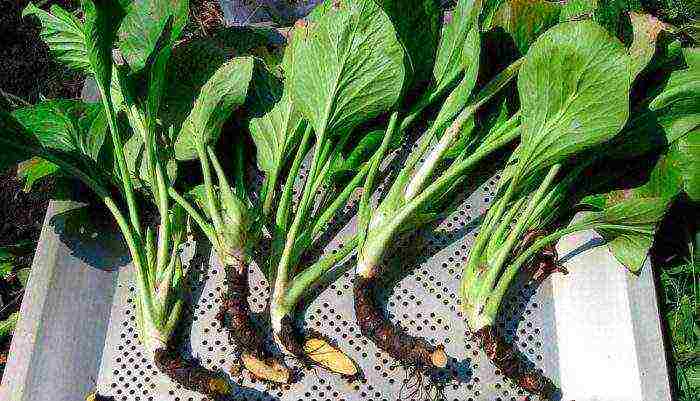
This method of breeding badan is quite simple. When new roots grow, they are very close to the surface of the soil, and therefore they can be easily dug out without damaging the mother rhizome. Thus, the plant is propagated in May or June. The divisions should contain at least 3 buds and 2-3 leaves. The separated roots are planted in pits with a depth of 10-15 centimeters, and they are placed 30-50 centimeters apart. Planted cuttings need to be watered abundantly. The berry bush should be divided no more than 1 time in 4 or 5 years. At the same time, do not forget that this flower grows wider, and it requires a large amount of free space.
Care features
It is very easy to care for this plant. In autumn, dried inflorescences need to be removed from him, and in spring - withered leaves. In the 1st season, after the berry is planted, you need to mulch the ground (with any method of reproduction). Watering is done as needed, but make sure that there is no overdrying of the earth. Also, mineral fertilizers must be applied to the soil. In the spring it is recommended to use the universal fertilizer "Kemira Lux", and in the autumn - a solution of superphosphate fertilizer (20 grams per 10 liters of water per 1 square meter of land).
Remember that badan is extremely negative about transplants, and it grows and develops quite well in the same place for 10 years.
Main types
Badan thick-leaved
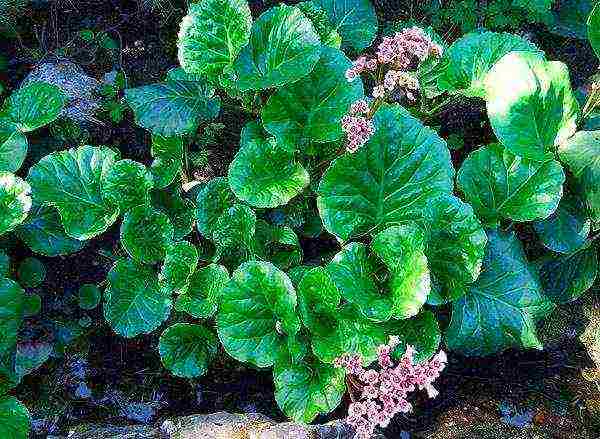
The bush reaches a height of half a meter. The fragrant flowers are dark pink, and the shiny leaves are light green. In autumn, the leaves change their color to brown-red.
Badan pacific
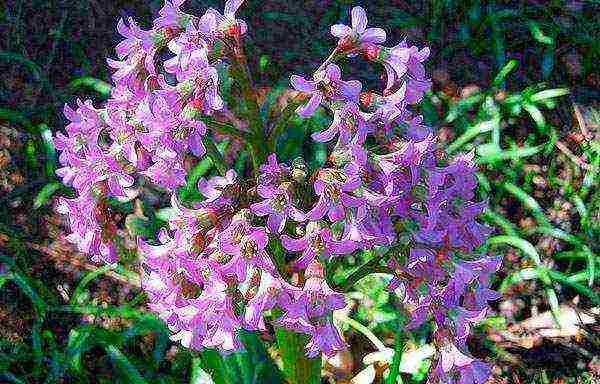
Its bell-shaped flowers are painted in a bright pale lilac color. The leaves are large (up to 20 cm in diameter), rounded.
Badan hearty
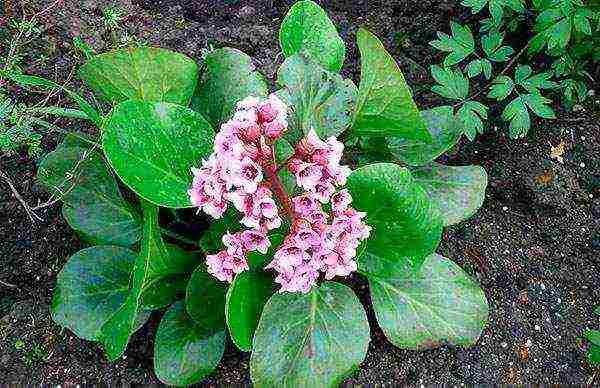
The height of the bush, depending on the growing conditions and the type of plant, is from 20 to 40 centimeters. The flowers are colored pink, purple, white or lilac. It has lush heart-shaped leaves.
Video review
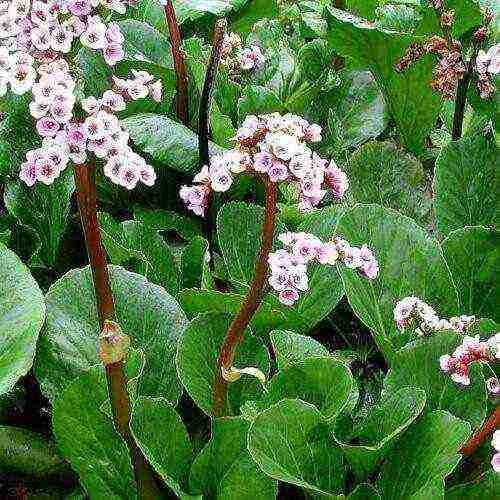
"Siberian tea" - this is how the badan plant is called. This beautiful and unpretentious flower has medicinal properties. You can meet in nature on rocky surfaces. Plants of lowlands and places along streams attract.
Content:
Description of the plant
Badan, which has the name "thick-leaved saxifrage", belongs to the category of evergreen and perennial plants. Badan is distinguished from other plants by the presence of a powerful thick rhizome and a bell-shaped inflorescence of fragrant flowers. Badan leaves are dark green in color. Plant height can reach 50 cm. The color palette includes white, pink, purple, purple, dark crimson options.
Attention! In culture, 5 varieties of badan are known. The most popular are thick-leaved and hybrid. The healing properties are more pronounced in thick-leaved bergenia.
Landscapers love to use this plant. There are several reasons for this:
- Several specimens planted side by side quickly cover the ground underneath with their bright green leaves.
- Badan "survives" the weeds.
- It goes well with a large number of plants.
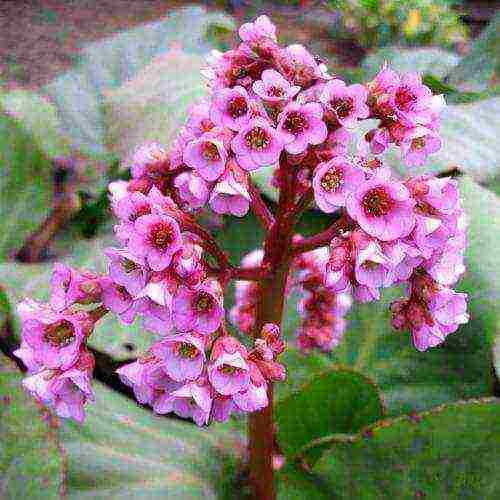
After winter, leaves with a brown tint appear from under the snow. Subsequently turn to green. The flowering period of the plant is from April to May.
Planting and caring for the plant
Badan, planting and caring for which is optimal in the spring, has another interesting property. The leaves change color to bright red in the midst of autumn, which perfectly complements any landscape of the season.
Before planting an incense in a new area, you need to make sure that the soil is suitable. It is better if the soil is:
- moisturized;
- drained;
- easy.
The plant thrives in partial shade. When planted in full sun or shade, the plant can survive but will not bloom profusely. A contraindication for planting badan is the presence of clay soil on the site. In addition, there should be no stagnant water. Otherwise, the plant will start to hurt or even rot.

You can grow badan from seeds or carry out vegetative propagation. After the plant is first planted in the ground, it feels great for ten years. The berry cannot withstand frequent transplants.
Important! Planting and grooming outdoors is more desirable. But in some cases, those who want to see badan throughout the year, plant the plant in greenhouses.
Features of plant care
In the dry season, watering "Siberian tea" should be watered once a week. Although in general, the plant tolerates drought without problems.
Among the main recommendations for care are:
- Plant feeding should be carried out in the spring after flowering.
- Remove dry inflorescences. An exception is if seed propagation is planned.
- It is necessary to carefully clean the plant from dry leaves in the spring in order to prevent a blow to the root by suddenly returning frosts.
- Protect the plant from weevils.
- For the winter, the roots of the plant should be covered so that it does not freeze out.
Attention! Badan does not like abundant watering, which can lead to stains on its leaves.
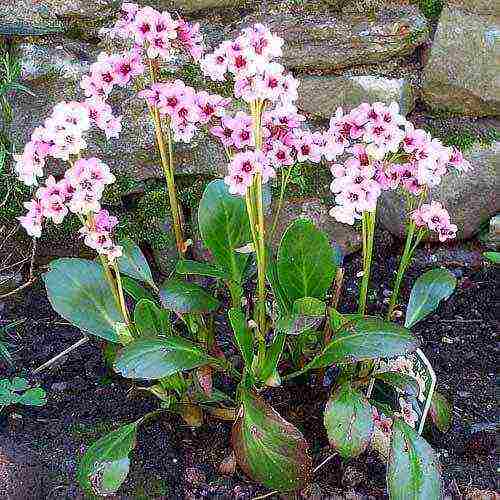
There are many varieties of badan on sale that are not adapted to the harsh winter conditions. If the plant is not covered for the winter or dry foliage is cut off in the fall, then in the spring the badan will have to spend energy on restoring the greenery. Such a plant will not be able to bloom.
Considering that "Siberian tea" grows in breadth, when planting between the rosettes, the plants should be left from 30 to 50 cm so that they do not interfere with each other during development.
To help the plant develop successfully, it is recommended to feed it. This is usually done before flowering. The following composition can be used as a feeding agent:
- 2 tablespoons of nitrophosphate;
- 5 kg of compost;
- 5 kg of peat.
All these components are thoroughly mixed together and laid out under the leaves of the plant.
Badan breeding methods
The easiest way is to divide the badan socket into parts and transplant to a new place. The root of the plant is close to the surface. Even if you take a segment with one bud, the plant will take root easily.
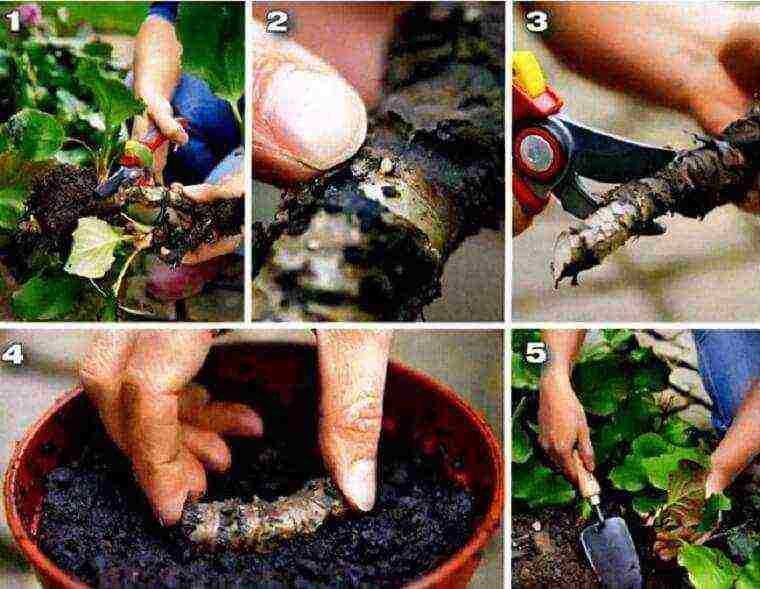
Plant propagation
Experienced gardeners also advise planting a tilted line. This ensures faster rooting of the plant, as well as an increase in the number of vegetative buds. That will allow you to quickly carry out a new breeding of badan.
Badan planting time
Those wishing to use this method of transplantation usually ask, at what time do you need to share the badan? Planting and leaving in late autumn in this case will be a mistake. The most favorable period is the end of July - August. This will additionally lead to the fact that the berry will not thicken on the territory.
Planting with seeds and care in the garden in the future is carried out, on the contrary, from the spring period. In this case, the plant will have time to harden well before frost. If you want to plant badan seeds in the fall, then you should additionally cover the area chosen for planting with peat or sawdust. This will increase the chances of spring shoots.
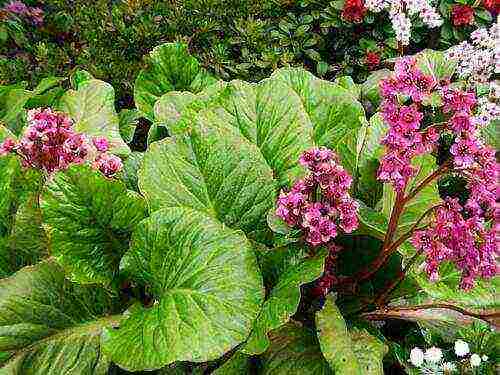
Disadvantages of the seed method of plant propagation:
- Long period of growing the plant.
- Low germination of seeds planted in autumn.
- After germination, a transplant will be required (reproduction takes place in two stages).
- In the first year, the plant will only produce 5 leaves, which does not allow the outlet to be used for design purposes.
Attention! Siberian tea can be planted as seedlings. In order for the plant to gain enough strength, seeds should be planted in boxes or containers in February.
Plants that have been obtained from seeds should bloom only after 3-4 years.
Badan diseases
Like any plant, bergenia can be affected by any disease. Although it should be noted that pests do not attack badan so often. Diseases are mainly fungal in nature, and are associated with the wrong choice of soil or care.
The leaves of the plant are most often affected. They can become "full of holes" due to the work of slugs, snails, weevils. In this case, it is necessary to treat the plant with special chemical agents. You cannot use them in hot weather, which can destroy the plant.
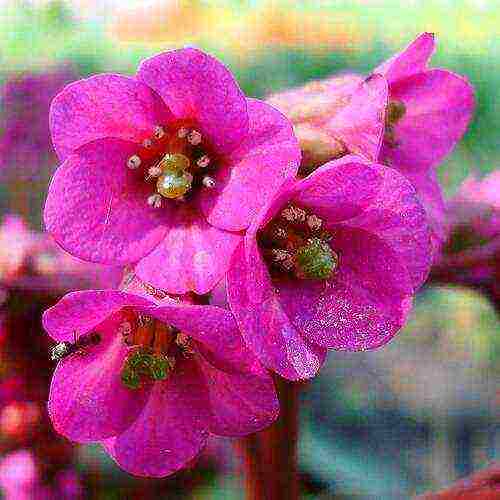
Rarely, but the plant is damaged by nematodes. It is difficult to get rid of this type of pest. They lay their eggs on the berry rhizome. As a result, even cleaning the soil is not able to get rid of the problem. If a decision is made to transplant badan, then chemical treatment is carried out in its place, and for a long time they do not plant in this area.
Important! If spots appear on the leaves of the plant or the berry has stopped blooming, you should make sure that there is no excessive moisture. In addition, nitrophobic or ash treatment can be carried out.
An amazing and versatile in its properties, the berry plant will definitely please its owners for its unpretentious care and discreet, but individual appearance.
Badan is an evergreen perennial plant of the saxifrage family that grows in its natural environment on rocky terrain or in mountain gorges.
This plant has a well-developed root system, large dark green leaves with a glossy or matte sheen, numerous bell-shaped flowers collected in shield-like inflorescences (each about 2 cm in diameter) of various colors.
The plant with its healing properties is widely used in folk medicine and cosmetology, especially as a healing and anti-inflammatory agent.
Badan is grown both in the garden and on the windowsill at home. Blooms throughout the last month of spring, capturing the first decade of summer. In the autumn, the foliage of this plant begins to accumulate nutrients for the winter, while changing its color to a bronze or brown color, which remains until spring.
Badan and features of its cultivation
Badan, a resident of Altai, Siberia and the Far East, is considered a rather unpretentious plant, resistant to cold and other unfavorable conditions. But still, there are certain nuances and features of its cultivation:
• It is possible to grow bergamo in any light - in the sun, in shady places, it doesn't matter, the only difference is that in bright enough daylight, the plant blooms well, but does not grow very well.
• The height of some species of this plant can reach half a meter.
• This plant feels comfortable enough even on poor, poor soils. In this connection, the developed garden land of low fertility will be the best option for growing and growing this flower.
• This flower needs drainage, as it does not tolerate waterlogging of the soil. It is recommended to water the plant abundantly only during the period of bud formation.
• Badan can grow for a long time in the same place. If you often transplant this plant, its appearance deteriorates and changes for the worse.
Badan planting and caring for a plant in the open field
Badan, planting and care, which is carried out by gardeners, according to the existing rules, grows into a strong and beautiful plant.
Planting a plant
Before you start planting this plant, you must select the area, picking up the soil not with clay and stony soil, but with soddy soil or soil diluted with sand, gravel, without stagnant water and excessive vegetation.
The right time to plant Badan is spring or the end of the summer season.During this period, it is necessary to prepare the soil for planting a plant - to improve its composition, if necessary, to destroy weeds, to loosen it.
After that, you need to dig a hole (up to 35 cm) and mix the plant into it, sprinkling it with earth on top.
Important! Planting the plant must be done with great care to avoid damage to the root system.
You can also pre-fill the prepared hole for planting Badan with water and place the rhizome of the plant in it, cover it with a layer of soil on top. And then, tamp the soil together with the sawdust and peat introduced into it.
When planting a plant in the last way, Badan will need watering only after 5-6 days.
Plant care
Caring for the berry is not burdensome, but for the normal growth and development of the plant, it is still necessary:
• Badan needs regular and abundant watering, but without further stagnation of water, in connection with which the soil must be loose and have time to dry out. It is best to water once a week.
• The plant is very fond of carrying out the necessary fertilizing for it. Before flowering, the introduction of mineral fertilizers, and after it, after half a month, re-feeding to activate the process of the appearance of new and aging of existing leaves, which during this period begin to change their color.
• The soil where the berry grows must be mulched - with peat, humus 2 - 3 times per season.
• It is also necessary to control weeds and thin out plantings in time.
In its natural environment, Badan grows in places where in winter the temperature reaches - up to 40 degrees, and the summer is saturated with sharp thaws. In this regard, in order to prevent damage to the leaves and the root system with the arrival of frost, it is better to cover the plant with a special material, thereby protecting it from winter winds, and in summer from sunburn.
Badan and its reproduction
Badan reproduces both by seed and by dividing the bush:
- For reproduction by seed, it is necessary that the planting material is large and famous for its germination. The soil should have the following composition:
• Peat.
• River sand.
• Crushed stone.
You can also use a substrate intended for indoor plants to germinate seeds. Having filled up a pot, container or simply a wooden box with soil mixture, then it is necessary to spill the earth in the container with water at room temperature. And then, after 2 centimeter intervals from each other, make holes (1-2 cm deep) by placing seeds in them. Then they need to be sprinkled with the existing mixture and placed in a container and a fairly light and warm place. The air temperature of the room where the berry seeds germinate should be about 20-22 degrees. Berry seeds germinate for a long time, about a crescent or more. But, and then it begins to develop rapidly and intensively, growing in a few days up to 10-12 centimeters. At the end of spring, the plant can already be safely planted in open ground.
- In just a couple of years, a small berry bush can grow in the garden and occupy the entire flower bed. This is due to the intensive growth of the rhizome of the plant, which, after wintering, begins to throw out its shoots. Carefully digging up the berry at the base, the new shoots of the rhizome can be cut off, planting them in other places of the personal plot. In order not to harm the maternal root, it is more expedient to divide the processes in the spring, then by the summer the berry will bloom profusely, and look like a rather lush flower.
Important! Badan begins to bloom two years later, no earlier.
Badan in the open field
Before transferring berry seedlings to open ground, it is necessary to fertilize the soil well. For this, compost, ash, manure are applicable. After that, ridges can be formed. But it is more advisable to plant flowers in open ground no earlier than a week later, already in prepared loosened soil.
A place for planting badan needs to be selected sufficiently illuminated, not far from the water.
In early spring, this plant must be pruned to remove unnecessary overgrown shoots.
And for the duration and quality of flowering, it is recommended to cut off all the lower leaves of the plant, which can then be perfectly used in cooking or in folk medicine.
At the first wintering of badan in the open field, it is more advisable to cover young shoots with fallen leaves in autumn, then the root system will not freeze for sure and after the snow melts, the plant will again begin to delight its amateur florist with luscious green foliage, and in the future with lush flowering.
source

